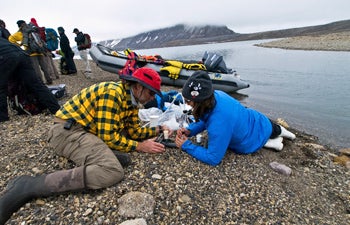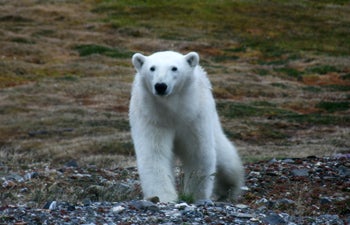One Bear of a Research Trip
Dressed in layers of thermal underwear, a wool sweater, raincoat and balaclava, Cara Magnabosco trekked 2 1/2 miles in below-freezing weather lugging 30 pounds of gear to her research destination each morning.
That’s how scientists roll in the Svalbard Islands, faraway in the Arctic Ocean halfway between Norway and the North Pole.
The USC College senior’s in-the-field laboratory was a shed. She cobbled together a workstation by placing an unhinged door across two boxes. It’s not every day that microbiology research requires two weeks of survival skills training.
Magnabosco’s did. Among other things, she learned to shoot a rifle, which she kept with her at all times slung around her chest. Her six-week trip to the island of Spitsbergen in Svalbard this past summer was part of a National Science Foundation (NSF) Research Experiences for Undergraduates fellowship. The biochemistry major was among 12 students nationwide chosen for the program. After gathering water samples from two lakes, she’s examining any link between nutrient limitations and climate change.

Cara Magnabosco helps to filter water with other researchers at a lake in Svalbard. Photo credit Jordan Mertes.
She brought home more than 500 samples and continues to evaluate the chlorophyll, bacterial, nutrient, and nitrogen gas materials with support from Women in Science and Engineering (WiSE). In March, she will present her research thesis at a NSF event in Montreal, Canada.
“We’re trying to get a better understanding of the biogeochemical cycling in fresh water lakes and what changes are occurring due to climate change,” Magnabosco said. “[Svalbard] is one of the most sensitive regions to climate change and it’s going on right now. But the area has never really been looked at before from a biological perspective.”
Magnabosco didn’t know she could be so passionate about science. She arrived at USC in 2008 as a USC Viterbi School of Engineering major. With an emphasis on environmental engineering, she interned in the lab of Ken Nealson, Wrigley Chair of Geobiology. She became fascinated with microorganisms and approached Doug Capone, Wrigley Chair of Biology, about switching her major.
“Being a scientist is a little bit more innovative, more creative, more focused on understanding the concepts behind the applications,” said Magnabosco, who has a minor in entrepreneurship in USC Marshall School of Business. “Deep down I’m an engineer at heart. I love math and real world applications. But in order for me to be effective, I felt that I needed to understand and have a strong foundation in chemistry, biology and microbiology.”
After changing her major, she began working in Capone’s lab through a Student Opportunities for Academic Research (SOAR) grant. Among other things, she sampled algae on two field expeditions in Capone’s project studying metal controls on nitrogen cycling in California lakes. Then through a Summer Undergraduate Research Fund (SURF) grant, she did lab work in 2009 at the Wrigley Institute in Catalina, followed by an internship in the lab of Eric Webb, assistant professor of biological sciences.
“They were the main professors who talked to me, taught me and got me exposed to science and all the research opportunities,” she said.
Her research opportunity in Svalbard included a few surprises. Students had learned to shoot a rifle to protect themselves from polar bears. That proved to be wise. During her first week conducting field research, an emaciated polar bear wandered into their base camp.
“He was hungry,” Magnabosco said. “He was abnormally skinny. He hung around our base camp probably because he could smell food.”
Polar bears are considered marine animals because they live predominately on sea ice and consume seals.
“Polar bears are dying because the sea ice is melting and it is becoming harder for them to hunt,” Magnabosco said. “They’re coming inland in hopes they can scavenge something off the ground.”

An emaciated polar bear wanders into Magnabosco’s camp searching for food. Photo credit Silje Naarstad.
The polar bear got close to their camp.
“He got right up to the building,” she said. “We could see him pass by the window. We weren’t allowed to go out except to eat. When I had to go from my room to the dining room, two people carrying rifles escorted me.”
Reading about it is one thing, but seeing the melting ice in person was startling, she said.
“When we hiked up to one glacier, we could see the imprint of where it once was and where it is now,” she said. “We could plainly see how much it’s melted back. It was significant.”
She roughed it in Svalbard and wants to go back for more. She has applied for a Fulbright scholarship and hopes to return to Svalbard to conduct research for a year before entering graduate school.
In the near future, Magnabosco wants to study aquaculture — or fish farming. It involves cultivating freshwater and saltwater populations under controlled conditions. Fish farming is crucial right now because many valuable fish species are disappearing from oceans in the United States due to over harvesting, loss of habitat and pollution.
“Since aquaculture is a relatively young industry, I want to focus on making it more sustainable now because we have an opportunity to do it right,” she said.
“Through my research, I know that if you take out algae in a pond, the yield of the fish pond can increase significantly. Not only would that bring profit, but the algae can be used as a food source and be put back into the pond. Or it could be burned to make energy. There’s so much potential for improving the environment and making the ponds profitable at the same time.”